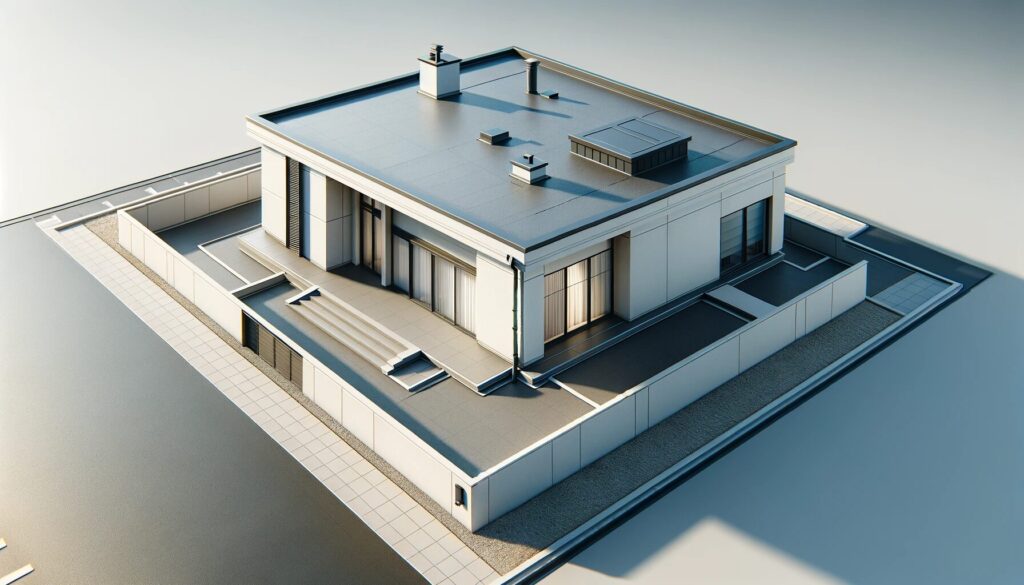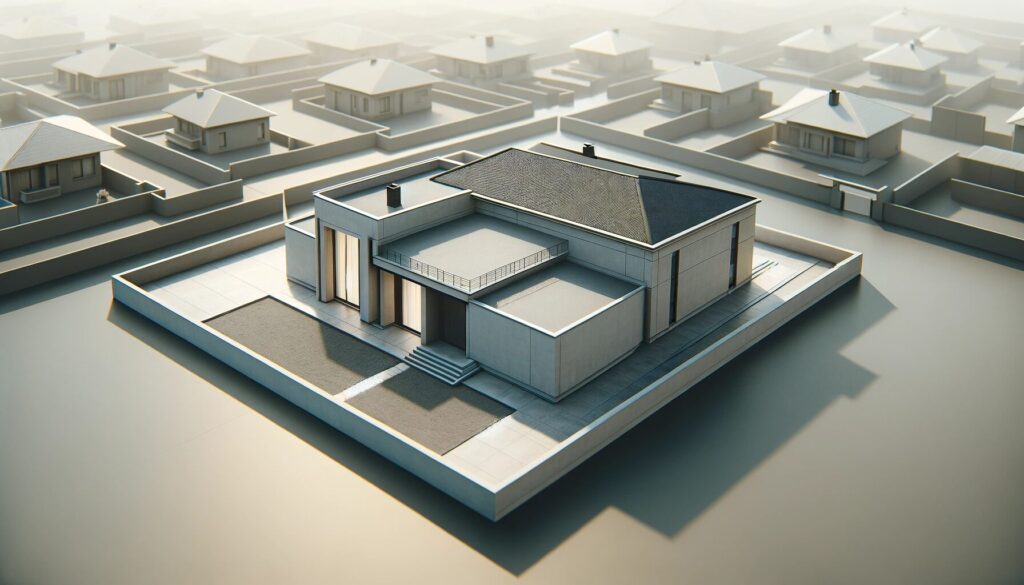In the world of flat roofs, the right choice of materials is more than a mere selection—it’s a critical decision impacting the longevity and performance of your roof. Whether you’re a DIY enthusiast tackling your home project or a seasoned contractor managing numerous sites, the nuances of flat roofing materials play a pivotal role in the success of your endeavor. It’s a balancing act between cost, functionality, and aesthetics.

Understanding Flat Roofs
Defining a Flat Roof
A flat roof, often misconstrued as completely level, actually boasts a subtle incline, usually about 1/4 to 1/2 inch per foot, essential for draining water. This minimal slope sets it apart from the more steeply pitched roofs and brings unique challenges and solutions.
Flat vs. Sloped Roofs
The choice between flat and sloped roofs isn’t just aesthetic, it’s practical. Flat roofs, commonly seen in modern and commercial buildings, are lauded for their space efficiency and cost-effectiveness. However, they require more attention to waterproofing and drainage than their sloped counterparts due to their propensity for water pooling.
Key Factors in Choosing Flat Roof Materials
Durability: The Longevity Factor
- Impact of Climate: In regions with heavy snowfall, robust materials capable of supporting snow loads are vital. In contrast, areas with intense sunlight demand materials with high UV resistance.
- Real-World Example: In a project in a hot, arid region, EPDM roofing proved invaluable for its resistance to sun damage, demonstrating the importance of climate-appropriate material choice.
Maintenance: The Care Consideration
- Repair-Friendliness: Some materials, like modified bitumen, are more conducive to DIY repairs, while others may require professional intervention.
- Routine Maintenance: Regular inspections and maintenance are as crucial to your roof’s health as regular oil changes are to your car.
Cost: Balancing the Budget
- Immediate vs. Long-Term Costs: While some materials like BUR are affordable upfront, they may incur higher maintenance costs. Conversely, materials like PVC, though initially more expensive, can offer long-term savings through lower maintenance needs.
- Practical Insight: Experience teaches that the cheapest option isn’t always the most cost-effective in the long run. Consider the entire lifecycle cost of the roofing material.
Aesthetic Appeal: Visual Harmony
- Matching Home Design: Flat roofs can enhance a home’s modern appeal. The use of materials like metal can add a contemporary flair, while options like green roofing can integrate a natural element.
- Case Study: On a project involving a flat-roofed extension, the use of a green roof not only elevated the aesthetic appeal but also significantly improved the building’s insulation.

Popular Flat Roof Materials
Built-Up Roofing (BUR)
- Composition: BUR is a time-tested method, akin to a layered structure. It’s built with multiple layers of bitumen interspersed with reinforcing fabrics, culminating in a gravel or stone layer.
- Advantages: BUR is renowned for its durability, particularly against foot traffic, and offers excellent waterproofing capabilities.
- Limitations: Its heavyweight demands a robust underlying structure. Additionally, the installation process is labor-intensive and requires considerable skill.
Modified Bitumen
- Features: Modified Bitumen is a modern twist on BUR, featuring enhanced flexibility and durability. It incorporates polymer-modified bitumen sheets, resulting in a more resilient and adaptable material.
- Installation Process: Options include torch-down, self-adhesive, and cold-applied methods. Precision in application is crucial, particularly with torch-down methods, to ensure effective bonding and prevent fire hazards.
- Longevity: With proper installation and maintenance, Modified Bitumen roofing can last up to 20 years, offering a solid balance of cost and durability.
Rubber Membrane (EPDM)
- Flexibility: EPDM is akin to a robust rubber sheet, offering significant flexibility. It’s adept at accommodating structural movements and is highly resistant to weathering.
- Resistance to Weather: It excels in UV and ozone resistance, maintaining its integrity under various weather conditions.
- Installation Tips: EPDM can be ballasted, mechanically attached, or adhered. Precise seam work is essential to ensure watertightness and longevity.
Thermoplastic Olefin (TPO) and Polyvinyl Chloride (PVC)
- Benefits: TPO and PVC are synthetic roofing materials known for their durability and versatility. TPO is noted for its cost-effectiveness and eco-friendly nature, while PVC is highly resistant to chemicals and oils.
- Durability: Both materials demonstrate excellent longevity and resistance to environmental factors. TPO, in particular, is known for its heat resistance.
- Eco-Friendliness: TPO is fully recyclable, aligning with environmentally conscious building practices.
Metal Roofing
- Types: Metal roofing comes in various forms, including standing seam and corrugated panels.
- Benefits for Certain Climates: Ideal for areas prone to heavy snowfall or high winds, metal roofs offer excellent durability and weather resistance.
- Aesthetic Options: Metal roofing is available in a wide range of colors and styles, allowing for customization to suit diverse architectural aesthetics.
Innovative and Eco-Friendly Options
Green Roofing
- Benefits for the Environment: Green roofs not only enhance a building’s aesthetic appeal but also contribute positively to the environment by reducing stormwater runoff and improving air quality.
- Insulation Properties: They provide natural insulation, reducing energy consumption for heating and cooling.
Solar Panel Integration
- How It Works: Solar panels can be seamlessly integrated into flat roofing systems, providing an efficient way to harness solar energy.
- Flat Roofing Materials Compatibility: Certain flat roof materials, such as PVC and TPO, are more conducive to solar panel installation due to their strength and durability.
Cool Roof Technology
- Reflective Materials: These materials reflect sunlight and absorb less heat, significantly reducing cooling needs and enhancing energy efficiency.
- Energy Efficiency: Cool roofs contribute to lower energy bills, reduced air pollution, and decreased greenhouse gas emissions.
Installation Tips for DIY Enthusiasts
Preparing the Roof Surface
- Clean and Inspect: Ensuring a clean, debris-free surface is fundamental. Any signs of damage or wear should be addressed before new material installation.
- Repairs First: Addressing any underlying issues is crucial for the longevity of the new roofing material.
Safety Guidelines
- Gear Up: Proper safety gear, including hard hats, gloves, and non-slip boots, is essential to prevent accidents.
- Buddy System: Never work alone. Having a partner ensures safety and efficiency.
Tools and Equipment
- Essentials: Basic tools such as ladders, safety harnesses, utility knives, trowels, measuring tapes, and hammers are indispensable.
- For Specific Materials: Specialized tools like hot-air welders for TPO and PVC and torches for modified bitumen are necessary for specific materials.
Professional Installation vs. DIY
When to Call a Professional
Complex Roof Designs: Roofs with multiple features such as vents, chimneys, or unusual angles require professional expertise. It’s similar to needing a specialist for a complex electrical job – the expertise is invaluable.
Specialized Materials: Some roofing materials, like TPO or PVC, demand specific tools and know-how. It’s akin to needing a master chef for a gourmet dish – the right skills make all the difference.
Safety First: If the roof’s height, pitch, or overall condition poses any risk, it’s prudent to hire a professional. It’s about prioritizing safety, much like calling an electrician for major wiring projects.
Cost-Benefit Analysis: DIY Savings vs. Professional Quality
DIY Cost Savings: Undertaking the project yourself can significantly reduce labor costs. It’s comparable to doing your own landscaping versus hiring a gardener.
Professional Workmanship: Professionals offer the advantage of quality, warranties, and often access to wholesale material prices. It’s an investment in craftsmanship and peace of mind, much like choosing a skilled carpenter to craft custom furniture.
Maintenance and Upkeep
Regular Inspection Tips
Seasonal Inspections: Inspect your roof biannually, in the spring and fall, to identify potential issues. This routine check is similar to servicing your vehicle – regular maintenance can prevent major problems.
Post-Storm Assessments: After severe weather, a thorough inspection is crucial. Storms can test a roof’s integrity just as a long road trip tests a car’s performance.
Repair Techniques
Leak Repairs: For materials like Modified Bitumen, use appropriate sealants or patching kits. It’s akin to applying a watertight sealant in plumbing – effective and practical.
Seam Maintenance: For single-ply roofing, reinforcing seams with tape or liquid membrane is essential. It’s similar to applying a strong adhesive to a loose tile – it secures and prolongs its life.
Longevity Tips
Consistent Cleaning: Regular debris removal and gutter cleaning are vital. This maintenance is like keeping your tools clean and rust-free – it extends their usefulness.
Prompt Repairs: Address minor issues immediately to avoid major repairs later. It’s like fixing a small leak in your home before it causes significant water damage.
FAQ Section
Modified Bitumen and BUR are both budget-friendly options. BUR, with its long history, is like the reliable family sedan, while Modified Bitumen offers a balance of modern efficiency and affordability.
Biannual inspections, during the spring and fall, are recommended. This regular check-up is akin to routine health screenings – preventive care is key.
DIY installation depends on your skill level and the complexity of the roofing material. Simple materials may be manageable, like undertaking a basic home painting project, but more complex systems often require professional installation.
Yes, options like green roofing, cool roofs, and solar panels are eco-friendly choices. These alternatives are comparable to using energy-efficient appliances at home – better for the environment and often for your wallet in the long run.
